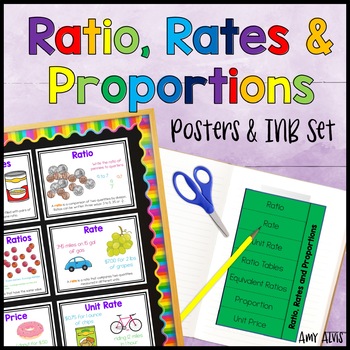Ratios Rates Proportions Posters and Interactive Notebook INB Set Anchor Chart
Amy Alvis
4.1k Followers
Grade Levels
6th - 7th
Subjects
Resource Type
Standards
CCSS6.RP.A.1
CCSS6.RP.A.2
CCSS6.RP.A.3a
CCSS7.RP.A.2
Formats Included
- PDF
Pages
15 pages
Amy Alvis
4.1k Followers
Also included in
- This Rates, Ratios and Proportions BUNDLE comes with two sets of task cards, a color by number activity, a poster set and an interactive notebook page to take notes.This bundles includes:Ratio task cardsRatio and Proportions task cardsUnit Rates color by code activity12 Days of Christmas Unit Rate TPrice $11.20Original Price $14.00Save $2.80
- This bundle includes all of my Poster and foldable interactive graphic organizer (INB) sets that fit 6th grade standards. Each set as at least one interactive graphic organizer for student notes and posters that are 8.5' X 11'. If you have topics that you would like to see created and added to thePrice $29.40Original Price $36.75Save $7.35
Description
This poster and foldable interactive notebook (INB) set covers ratio, rate, unit rate, ratio tables, equivalent ratios, proportion and unit price. This set includes ONE foldable interactive graphic organizers (INB) for student notes and SEVEN posters (8.5 X 11) that come in both color and a black and white version.
Thank you for looking,
Amy Alvis
Total Pages
15 pages
Answer Key
N/A
Teaching Duration
N/A
Report this resource to TPT
Reported resources will be reviewed by our team. Report this resource to let us know if this resource violates TPT’s content guidelines.
Standards
to see state-specific standards (only available in the US).
CCSS6.RP.A.1
Understand the concept of a ratio and use ratio language to describe a ratio relationship between two quantities. For example, “The ratio of wings to beaks in the bird house at the zoo was 2:1, because for every 2 wings there was 1 beak.” “For every vote candidate A received, candidate C received nearly three votes.”
CCSS6.RP.A.2
Understand the concept of a unit rate 𝘢/𝘣 associated with a ratio 𝘢:𝘣 with 𝘣 ≠ 0, and use rate language in the context of a ratio relationship. For example, “This recipe has a ratio of 3 cups of flour to 4 cups of sugar, so there is 3/4 cup of flour for each cup of sugar.” “We paid $75 for 15 hamburgers, which is a rate of $5 per hamburger.”
CCSS6.RP.A.3a
Make tables of equivalent ratios relating quantities with whole-number measurements, find missing values in the tables, and plot the pairs of values on the coordinate plane. Use tables to compare ratios.
CCSS7.RP.A.2
Recognize and represent proportional relationships between quantities.







